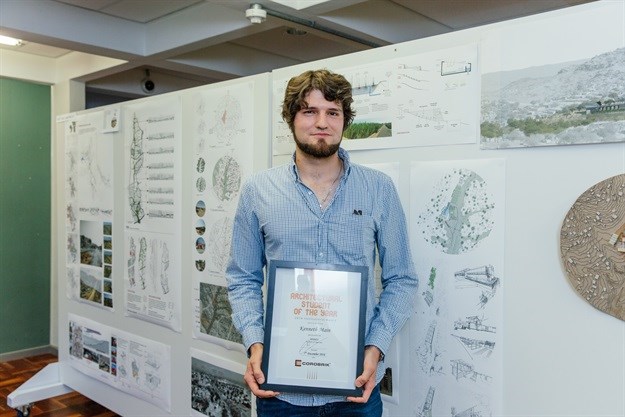
Christie van Niekerk, Corobrik Western Cape general manager, presented prizes to architectural students of the University of Cape Town in March. The regional winner of R8,500 was Kenneth Main, with Michèle de Villiers receiving the R6,500 second prize and Kayla Brown taking home the third prize of R4,500. The prize of R4,500 for the best use of clay was won by Christian Scriba.
Kenneth Main’s thesis is entitled Urban Acupuncture: Architecture as a catalyst for environmental and water conservation in the context of the Kilimanjaro Informal Settlement.
In his thesis, he attempts to establish an approach to dealing with the issue of waste contamination and water conservation in the natural and urban landscapes of the riverbed, its edges and man-made peripheries. The research locates itself at the northern boundary of the city of Windhoek along a stretch of polluted riverbed in the Kilimanjaro Informal Settlement (KIS). In the creation of an architectural approach ‘urban acupuncture’ is explored to create architecture that has the potential to influence areas beyond its physical boundaries. In addition, it can re-establish and re-imagine the value of the river for its unseen influence in shaping Windhoek as rapid urbanisation is taking place.
Aspects of environmental degradation, water conservation and lack of basic infrastructure form a basis of inquiry to which an urban framework is proposed. Most simply, this framework acts to establish an alternative and more efficient system which collects, stores, filters and reuses wastewater for both drinking and irrigation purposes through a series of four contextually assigned architectural devices. Utilising the ‘bi-products’ of this urban framework (reedbed filtered water and potable/drinking water), the KIS Agricultural Learning Centre is proposed. The centre provides a point of exchange for both in-situ filtered drinking water and fresh produce that is grown at the centre establishing a link between this infrastructural insertion and its public and social constructs.
“We expect the architectural students to be conscious of the big picture and the global environment in which they operate,” said van Niekerk. “This includes the concept of sustainable building and an awareness that life cycle impacts are critical to the design of environmentally responsible buildings. It was clear that this was the case with the winning students this year.”
The correct choice of building materials was a factor in ensuring environmentally friendly construction practices, van Niekerk said, and it was hard to ignore the sustainable properties of clay masonry in this regard.
“Energy efficiency is an increasingly important consideration in reducing environmental impact and it here that face brick comes into its own because of its thermal efficiency, helping to keep the interior of buildings cool in the hotter months and warm in winter, a benefit which is of particular importance in South Africa with its extremes in temperature. Superior thermal efficiency also means lower energy costs throughout the life cycle of a building and peace of mind knowing that the first cost is essentially the last cost.”
“The architectural and building sector are increasingly receptive to the idea that, when considering the life cycle costs of a project, eco-friendly buildings cost less to operate and have excellent energy performance. As a result, we are seeing architects creating designs for environmentally sound buildings, a trend that was manifested in the projects submitted by this year’s students and one which bodes well for the furtherance of world class architectural design in this country.”